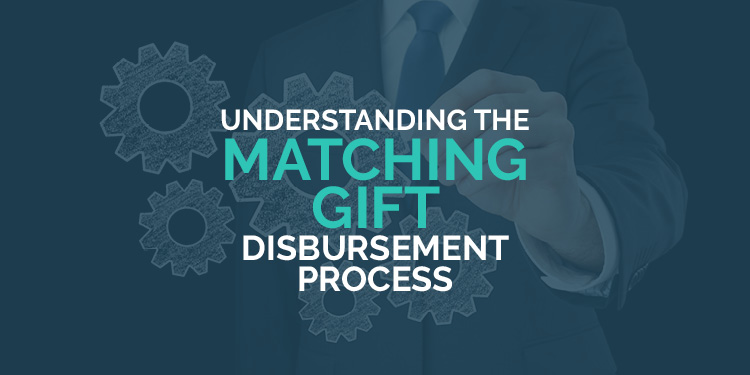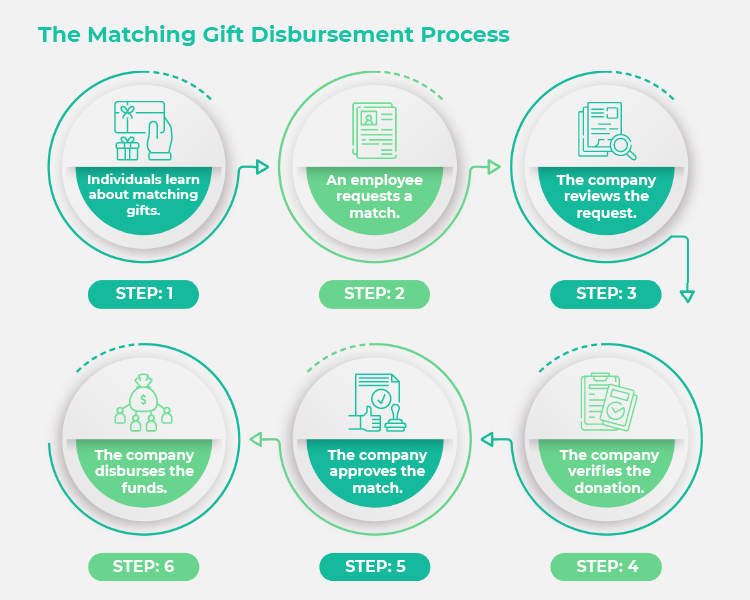
Thousands of companies are looking to get further involved in corporate philanthropy and workplace giving programs, a favorite of which is matching gifts. This is excellent news for a wide range of participating businesses, employees, and nonprofits. Unfortunately, the matching gift disbursement process remains a mystery to many.
The Problem
Despite the $2 to $3 billion donated through matching gift programs on an annual basis, an additional $4 to $7 billion in match funds are left on the table each year (according to matching gift research by Double the Donation). That means neither corporate contributors nor nonprofit recipients are making the most of their matching gift potential.
One of the biggest roadblocks for maximal matching gift participation—besides a lack of donor awareness—is that the processes occurring behind the scenes can be a bit fuzzy for matching gift novices and fundraising experts alike. And when many are not entirely sure how matching gifts work, some are hesitant to get involved.
Thus, we’ve created this resource to help explain the matching gift disbursement process to any corporation, organization, or individual looking to learn more.
Here, we’ll share a brief overview of what matching gift disbursement is, then dive into the five key steps involved in the process:
- Step #1: Individuals are informed about matching gift opportunities.
- Step #2: An employee submits a matching gift request to their company.
- Step #3: The company reviews the matching gift submission request.
- Step #4: The company verifies the initial donation with the nonprofit.
- Step #5: The company approves the donation match and disburses the funds.
Then, we’ll explore the various ways that matching gift software can play a role in the matching gift disbursement process for the better.
Ready to dive in with the basics of matching gift disbursement? Let’s begin!
Matching Gift Disbursement: The Definition
Matching gift disbursement essentially describes how corporate match funding goes from Point A (the companies) to Point B (the nonprofits). Though the specific processes can vary dramatically from one business to another, the basic premise remains the same:
Employees donate and request matching funds. Companies approve employees’ requests and make their own donations. Nonprofits receive individual and corporate funding.
It’s a win-win-win situation!
A key differentiating factor in the matching gift disbursement process will depend on whether the company providing the funds manages its own giving program or outsources administration to a third-party CSR vendor. It’s possible for corporations to handle the behind-the-scenes aspects of these programs internally. However, it can be expected that each step may take a bit longer to complete and require additional effort on the part of the company, the donor, and the nonprofit when the company chooses to manage its CSR program in-house.
That said, let’s see what the process looks like in further detail.
Key Steps in the Matching Gift Disbursement Process
Successful corporate matching gift efforts typically follow five basic steps. Since matching gifts function as a group effort between companies, employees, and nonprofits, different parties will carry out different tasks.
However, the disbursement process itself falls largely into the corporation’s realm—meaning the contributing company will play a huge role in ultimately driving the match to completion.
Here’s how it works!

Step #1: Individuals are informed about matching gift opportunities.
Party responsible for this step: Companies and nonprofits
Millions of match-eligible employee donors never participate in their companies’ donation-matching programs, and one of the biggest reasons is that they simply don’t know that the programs exist. In order to overcome this roadblock, businesses and nonprofits everywhere are working to better educate their respective employees and donors about available matching gift opportunities.
Business owners looking to do so should highlight matching gift programs to eligible employees during the onboarding process, include a blurb within their benefits materials and policy handbooks, and send regular internal communications reminding individuals about the opportunities.
Nonprofits, too, should aim to expose every donor to the idea of matching gifts. Perhaps they’re familiar with the concept from their employers’ communications—but many likely won’t be! We recommend prominently displaying matching gift information across a nonprofit’s website and donation forms, sharing educational content on social media pages, and sharing program guidelines in personalized donation follow-ups.
Step #2: A match-eligible donor submits a matching gift request to their company.
Party responsible for this step: The employee donor
There are a few key ways in which an individual can submit a matching gift request to their employer, and we’ll walk through each form here.
Here’s an overview of each;
THE LEGACY REQUEST PROCESS
Once a match-eligible donor submits their initial gift to the nonprofit, they should be prompted (by the organization to which they gave) to see if their donation is match-eligible. While some donors may jump straight into the request process, others won’t—and they have up until a specified deadline provided by their employer to complete their submission.

Once a donor begins the matching gift request process, it should be pretty straightforward. Submission instructions should have been provided either by their employer or the nonprofit, which most often leads to an online submission portal where employees complete their requests. However, some companies still manage their matching gift programs manually with downloadable PDFs or even paper forms.
Regardless of the format, employees are typically asked for the same basic information: the name, location, and tax ID number of the organization, a copy of their official donation receipt, and other basic details describing their charitable gift.
Once the employee has provided the requested information, they submit the online (or paper) form to the company, and they’ve completed their part of the matching process.
Step #3: The company reviews the matching gift submission request.
Party responsible for this step: The company or CSR platform
At this stage in the disbursement process, the employing company is provided with the information on the initial donation and determines whether the gift qualifies for a corporate match. This decision is typically based on the match eligibility criteria communicated to employees ahead of time—including donation minimums and maximums, qualifying types of employees, qualifying types of nonprofits, and submission deadlines.
If the employee’s gift meets the aforementioned criteria, it is passed along to the next step in the matching gift disbursement process. If the gift fails to meet certain criteria, however, the request is likely denied.
Keep in mind that while some companies may manually screen donation requests to ensure they meet the corporation’s match guidelines, many others enlist the help of a CSR platform to streamline and automate the review of these requests.
Step #4: The company verifies the initial donation with the nonprofit.
Party responsible for this step: The company or CSR platform (sometimes the nonprofit or donor as well)
The extent to which this step takes place depends largely on the corporation contributing the funds, with companies falling anywhere along a broad spectrum of strictness and leniency.
For example, some companies enact firm verification procedures that include reaching out to the organization itself to secure confirmation of the employee’s gift.
Others leverage an automated process that simply verifies the validity of the organization at hand (such as those having gone through a corporate giving platform’s screening process).
Many still require proof of the initial donation in the form of a donation receipt, while they avoid going as far as to contact the organization itself for further verification.
Essentially, the purpose of this process is to ensure that employees actually made the donations they said they did. While the decision is ultimately up to each participating company, we recommend erring on the side of trusting one’s employees.
Step #5: The company approves the donation match and disburses the funds.
Party responsible for this step: The company or CSR platform
Again, this step can vary depending on the company disbursing the matching gift funds. While some companies prefer to manually review and approve each match request, others take an automated approach to save their teams’ time and effort.
For companies that automate their matching gift approval procedures, the CSR platform typically scans the provided information and compares it against the pre-determined guidelines. If all criteria match, the funds are automatically disbursed to the organization.
On the other hand, companies taking the manual approach will conduct their own screenings to determine if requested matches meet their matching gift eligibility criteria. If so, the company makes their matching donation to the organization, effectively concluding the matching gift disbursement process.
Software in the Matching Gift Disbursement Process
Like many tasks in the nonprofit and corporate worlds alike, having the right software can make a huge difference in terms of success, efficiency, and impact. Luckily, innovative solutions enable both organizations and companies to improve their matching gift initiatives, effectively streamlining the disbursement process.
For companies
Since corporations take on the bulk of the matching gift disbursement efforts, arming these teams with top-of-the-line technology is essential.
With a CSR or corporate giving platform, companies can automate the processes involved with reviewing and approving match requests, disbursing funding to qualifying nonprofits, and more. Thus, there’s no need to have a team manually screening and greenlighting employee submissions—which saves your business valuable time, money, and resources.
For nonprofits
For much of the match disbursement process, nonprofits are waiting patiently for their donors’ employers to approve submitted matches and distribute expected funding. However, ensuring nonprofit teams are equipped with the right tools before and after the disbursement procedure makes a significant difference.
Specifically, a matching gift automation platform enables organizations to quickly and easily remind donors about available matching gift opportunities and track real-time match statuses throughout the request process.
(Bonus! Check out this article to learn more about re: Charity’s favorite matching gift software.)
Then, after a nonprofit receives its successfully disbursed corporate matching gifts, innovative donor management software can be a huge help. An effective fundraising CRM can help organizations track matching gift data, assign corporate matches to the original donations, and more.
Companies are looking to heighten their social impact efforts by exploring new types of corporate social responsibility and improving their existing philanthropic efforts. Before any team (on the nonprofit or the corporate side of the equation) can expect to see significant results, they should start with a solid foundation of knowledge surrounding the programs. And this includes the processes behind them!
Now that you have a better understanding of the matching gift disbursement process, you should be all set to begin raising, giving, and doing more.
Looking to learn more about corporate philanthropy and matching gifts? Check out these other impactful resources for charitable-minded audiences:
- Corporate Giving Statistics for Nonprofits & Companies. Visualize the impact—and the potential—of corporate giving with this powerful compilation of statistics. Explore the research to get inspired!
- Our Favorite Employee Matching Gift Examples. Check out some examples of successful matching gift programs in action with this list from the CSR experts at Selflessly. See which tips you can incorporate in your own efforts.
- Ways to Give: Your Guide to Employee Giving Preferences. As a company, you want to provide an optimal employee giving experience to ensure high levels of participation. Find out what research says is the best way to organize your programs in this guide.